Welcome to the Nikon D5000 Manual, your comprehensive guide to unlocking the full potential of this versatile DSLR camera. Designed to help photographers of all levels, this manual covers everything from basic operations to advanced features, ensuring you can optimize your shooting experience and achieve stunning results. Whether you’re a beginner or an experienced photographer, this manual provides detailed insights to help you master the D5000’s capabilities.
1.1 Overview of the Nikon D5000 Camera
The Nikon D5000 is a versatile and feature-rich DSLR camera designed for photographers seeking high-quality images and creative control. With a 12.3-megapixel CMOS sensor, it delivers crisp and detailed photos, even in challenging lighting conditions. The camera features a vari-angle 2.7-inch LCD screen, HD video recording, and an intuitive interface. Its compact design and ergonomic controls make it easy to handle, while advanced modes like Live View and Scene Modes cater to both beginners and experienced shooters. The D5000 is a powerful tool for capturing stunning stills and videos, making it an excellent choice for enthusiasts and professionals alike.
1.2 Importance of the User Manual
The Nikon D5000 user manual is an essential resource for understanding and optimizing the camera’s features. It provides detailed instructions on operating modes, menu navigation, and custom settings, helping photographers of all skill levels make the most of their device. The manual also offers troubleshooting guides for common issues and tips for maintaining the camera. By following the manual, users can avoid errors, enhance image quality, and unlock advanced functions. Whether you’re a beginner or an experienced shooter, the manual is a vital tool for mastering the D5000 and achieving professional-grade results.

Nikon D5000 Specifications
The Nikon D5000 features a 12.3-megapixel DX-format CMOS sensor, capturing images up to 4288 x 2848 pixels. It supports HD video recording at 1280 x 720 pixels (24 fps) and offers a 2.7-inch vari-angle LCD screen with 230,000 dots. The camera includes an ISO range of 200-3200, 11 autofocus points, and compatibility with Nikon F-mount lenses, making it a versatile choice for photographers seeking quality and flexibility in their work.
2.1 Megapixels and Sensor Type
The Nikon D5000 is equipped with a 12.3-megapixel DX-format CMOS sensor, delivering high-resolution images with impressive detail. The sensor measures 23.6 x 15.8mm, offering excellent light capture and color accuracy. This APS-C sized sensor is ideal for a wide range of photography, from portraits to landscapes. With 12-bit color depth, it ensures rich tonal gradations and vibrant colors. The CMOS technology enhances image quality while minimizing noise, making it suitable for both professional and enthusiast photographers. This combination of megapixels and sensor type provides a solid foundation for capturing sharp, high-quality images in various lighting conditions.
2.2 Image Resolution and Quality
The Nikon D5000 captures images with a maximum resolution of 4288 x 2848 pixels, ensuring sharp and detailed photos. It supports multiple image sizes, including 3872 x 2592, 2976 x 1968, and 1936 x 1296 pixels. The camera shoots in both JPEG and NEF (RAW) formats, offering flexibility for post-processing. With its 12-bit color depth, the D5000 delivers vibrant colors and smooth tonal transitions. The EXPEED image processing engine enhances overall image quality, reducing noise and improving color accuracy; This makes the D5000 ideal for capturing high-quality images in various lighting conditions, from portraits to landscapes.
2.3 ISO Range and Noise Performance
The Nikon D5000 offers an ISO range of 200 to 3200, expandable to ISO 100 and 6400 in Hi-1 mode. This wide range allows shooting in various lighting conditions, from bright daylight to low-light environments. At lower ISOs, images exhibit minimal noise, preserving fine details and color accuracy. As ISO increases, the EXPEED processor minimizes noise effectively, ensuring high-quality results even in challenging lighting. However, at higher ISOs, such as 6400, noise becomes more noticeable, particularly in shadows. Proper use of noise reduction settings can help maintain image clarity and overall quality.
2.4 Autofocus System and Speed
The Nikon D5000 features an 11-point autofocus system, providing fast and accurate subject tracking. The phase-detection AF ensures sharp focus acquisition, even in dynamic shooting scenarios. With AF-S (Single Servo AF) for stationary subjects and AF-C (Continuous Servo AF) for moving subjects, the camera adapts to various photography needs. The AF-assist lamp aids in low-light conditions, though it cannot function with the built-in flash. While the system is responsive, it may struggle with extremely fast-moving subjects or complex compositions, requiring users to adjust settings for optimal performance.
2.5 Video Recording Capabilities
The Nikon D5000 supports HD video recording at 1280 x 720 pixels with a frame rate of 24 fps, captured in Motion JPEG format. The vari-angle LCD screen allows for flexible framing, making it ideal for creative compositions. The camera features a dedicated D-Movie mode for easy video recording and includes in-camera editing options. An external microphone jack enhances audio quality, reducing wind noise. While the D5000 lacks continuous autofocus during video recording, its manual focus and live view AF modes provide precise control. This makes it a solid choice for casual videographers and photographers seeking a hybrid solution.
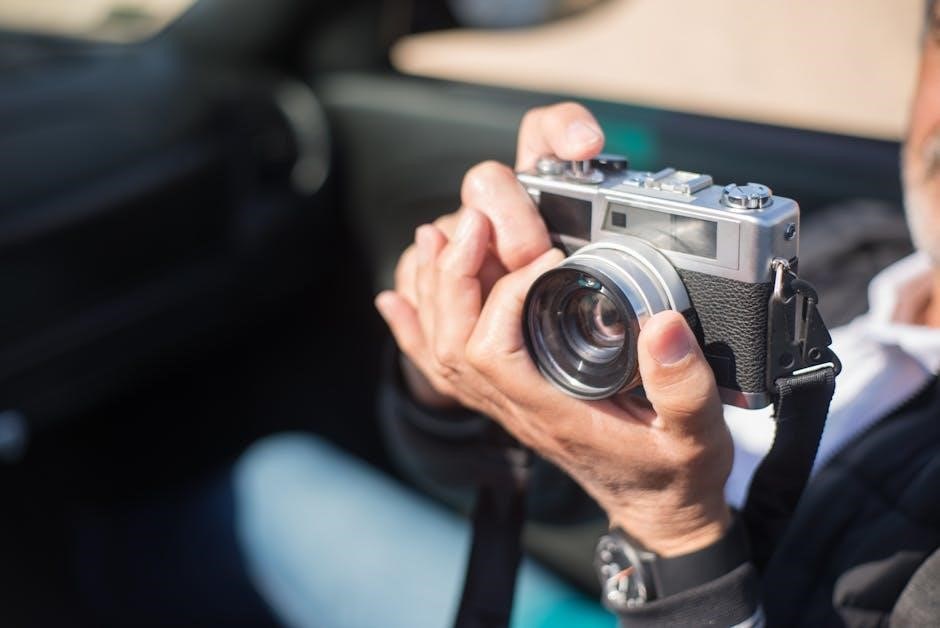
Camera Design and Ergonomics
The Nikon D5000 features a compact, lightweight design with a durable polycarbonate body, providing excellent ergonomics for comfortable handling. Its 2.7-inch vari-angle LCD screen offers flexibility and convenience for composing shots from various angles, enhancing creativity and usability.
3.1 Build Quality and Material
The Nikon D5000 boasts a robust and lightweight design, featuring a polycarbonate body that ensures durability while maintaining portability. The camera’s weather-sealed construction provides protection against dust and moisture, making it suitable for outdoor photography. The vari-angle LCD screen, with its sturdy hinge mechanism, adds to the camera’s versatility without compromising its overall build integrity. Ergonomic grips and intuitive button placement enhance comfort and accessibility, allowing photographers to focus on capturing moments effortlessly. The D5000’s build quality and materials reflect Nikon’s commitment to creating reliable tools for photographers of all levels.
3.2 Layout of Buttons and Controls
The Nikon D5000 features an intuitive and ergonomic layout of buttons and controls, designed to enhance accessibility and functionality. The mode dial on top allows quick access to shooting modes, while the live view button enables seamless transition to video or still image capture. The D-pad and OK button simplify menu navigation, and the vari-angle LCD screen provides flexibility in framing shots. Strategic placement of buttons like the exposure compensation and aperture controls ensures that key settings are easily adjustable, making the camera user-friendly for photographers of all skill levels.
3.3 Vari-Angle LCD Screen Features
The Nikon D5000 boasts a 2.7-inch, 230,000-dot vari-angle LCD screen, offering exceptional flexibility and clarity. This tilt-and-swivel display allows photographers to compose shots from unique angles, whether shooting low to the ground or above head level. The screen’s wide viewing angle ensures accurate color representation and sharp details, making it ideal for reviewing images, adjusting settings, or focusing during live view. Its compact size and sturdy hinge design add durability, while the anti-glare coating enhances visibility in bright lighting conditions, making it a versatile tool for both stills and video capture.
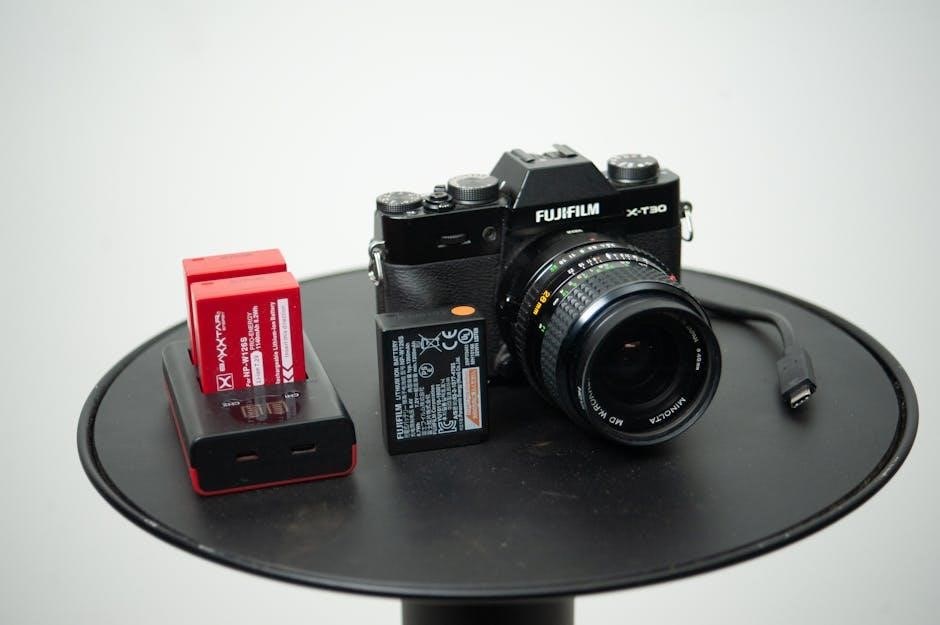
Operating Modes
The Nikon D5000 offers multiple operating modes, including Auto, Scene, Program, Aperture Priority, Shutter Priority, and Manual, catering to diverse shooting needs and skill levels. These modes provide flexibility and control, enabling photographers to capture stunning images in various conditions while enhancing creativity and precision in their work.
4.1 Auto Mode and Scene Modes
The Nikon D5000 features an intuitive Auto Mode that automatically adjusts settings for optimal results, ideal for beginners or quick shots. Additionally, it offers Scene Modes such as Portrait, Landscape, Night Portrait, and more, each tailored to specific shooting scenarios. These modes simplify photography by adjusting settings like aperture, shutter speed, and ISO to suit the situation, ensuring vibrant and well-balanced images. The Vari-Angle LCD screen further enhances composition flexibility, making it easier to frame shots from unique angles. These modes empower photographers to capture stunning images effortlessly, regardless of their skill level or shooting conditions.
4.2 Program Mode (P)
Program Mode (P) on the Nikon D5000 offers a balance between automation and control, making it ideal for photographers who want flexibility without manual adjustments. The camera automatically sets both aperture and shutter speed, but users can adjust these settings to achieve desired results. This mode is perfect for everyday shooting, as it adapts to various lighting conditions while allowing for creative input. The Vari-Angle LCD screen enhances composition, and adjustments like ISO and exposure compensation can be made easily. Program Mode strikes a great balance between convenience and customization, catering to photographers of all skill levels and shooting scenarios.
4.3 Aperture Priority Mode (A/Av)
In Aperture Priority Mode (A/Av) on the Nikon D5000, you control the aperture while the camera automatically adjusts the shutter speed. This mode is ideal for managing depth of field, allowing you to isolate subjects with a wide aperture or ensure sharpness across the frame with a narrow aperture. The D5000’s 12.3MP sensor and EXPEED processor deliver precise results, while the Vari-Angle LCD screen aids in composition. Adjustments to ISO and exposure compensation can refine your shots further, making this mode a flexible choice for creative photography, offering a perfect blend of control and automation.
4.4 Shutter Priority Mode (S/Tv)
In Shutter Priority Mode (S/Tv) on the Nikon D5000, you set the shutter speed while the camera automatically adjusts the aperture. This mode is perfect for controlling motion effects, such as freezing fast-moving subjects or creating artistic motion blur. With shutter speeds ranging from 1/4000 to 30 seconds, you can capture dynamic moments in sports or create silky water effects. The D5000’s EXPEED image processing ensures balanced exposures, while the Vari-Angle LCD screen helps frame shots accurately. This mode is ideal for photographers seeking creative control over timing and motion, offering a balance of automation and artistic expression.
4.5 Manual Mode (M)
Manual Mode (M) on the Nikon D5000 gives you full creative control by allowing you to set both the aperture and shutter speed manually. This mode is ideal for experienced photographers who want precise control over exposure settings. With the D5000’s intuitive controls, you can adjust the aperture using the command dial and the shutter speed with the sub-command dial. The built-in light meter provides accurate exposure guidance, ensuring your images are perfectly balanced. Manual Mode is perfect for capturing images in challenging lighting conditions or for achieving specific artistic effects, making it a favorite among professional photographers seeking ultimate control over their craft.

Menu Navigation and Customization
The Nikon D5000 offers an intuitive menu system, allowing users to easily navigate and customize settings. Access the main menu via the MENU button, and explore options like shooting modes, image quality, and autofocus settings. Customize preferences to suit your photography style and streamline your workflow for enhanced efficiency. The menu is organized into clear sections, making it easy to find and adjust settings quickly. Additionally, you can set the menu language to your preference for optimal usability.
5.1 Main Menu Sections
The Nikon D5000 features a well-organized main menu divided into clear sections for easy navigation. The Playback Menu allows you to review and manage your photos, including deleting, rotating, and slideshow options. The Shooting Menu is where you can adjust settings like image quality, white balance, and ISO sensitivity. The Setup Menu handles camera maintenance tasks such as formatting memory cards, cleaning the sensor, and setting the camera’s time. Additionally, the Retouch Menu offers in-camera editing options, enabling you to enhance your images without a computer. Each section is designed to streamline your workflow and improve your shooting experience.
5.2 Custom Settings and Preferences
The Nikon D5000 offers a range of custom settings to tailor the camera to your preferences. Through the menu system, you can adjust autofocus modes, metering patterns, and bracketing options. Custom settings allow you to personalize functions like the AE-L/AF-L button, autofocus tracking, and exposure compensation. Additionally, you can configure the camera’s controls to suit your shooting style, such as assigning specific functions to buttons or adjusting the sensitivity of the autofocus system. These customizable options ensure a more intuitive and efficient workflow, enabling you to maximize the camera’s capabilities and adapt to various photography scenarios with ease.
5.3 Accessing and Navigating Menus
To access the Nikon D5000 menu, press the Menu button located on the rear of the camera. The menu is divided into sections such as Shooting, Custom Settings, Playback, and Setup. Use the multi-selector to navigate between menu tabs and scroll through options. Highlight your desired setting and press OK to select it. The D5000 also allows customization of menu items, enabling quick access to frequently used features. For detailed instructions, refer to the Nikon D5000 Manual, which provides step-by-step guidance on menu navigation and customization, ensuring optimal control over your camera settings.
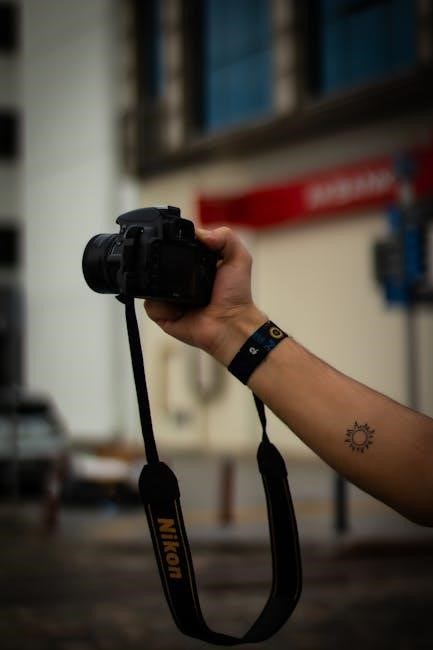
Advanced Features and Functions
The Nikon D5000 offers advanced features like Live View for precise focus control, HD video recording, interval shooting for time-lapse photography, and bracketing for dynamic range adjustment, enhancing both still and video capture versatility.
6.1 Live View Mode and Focus
Live View mode on the Nikon D5000 allows for precise framing and focusing using the vari-angle LCD screen. This feature is particularly useful for composing shots at unique angles or in challenging positions. The camera supports both Face Priority AF and Wide Area AF, enabling quick and accurate subject detection. Manual focus is also available, offering photographers full control over focus settings. The LCD’s flexibility ensures that even the most intricate compositions can be achieved with ease, making Live View an invaluable tool for both still photography and video recording.
6.2 HD Video Recording and Settings
The Nikon D5000 supports HD video recording, capturing high-quality footage at 1280 x 720 pixels with a frame rate of 24 fps. This feature makes it ideal for photographers who want to explore the world of videography. The camera allows manual control over aperture and shutter speed, enabling creative adjustments during recording. Users can also utilize the vari-angle LCD screen for framing shots from unique perspectives. Additionally, the D5000’s Motion JPEG format ensures smooth and detailed video playback. These settings provide flexibility for both casual and professional video recording needs, enhancing the camera’s versatility beyond still photography.
6.3 Interval Shooting and Time-Lapse
The Nikon D5000 offers an interval shooting mode, enabling users to capture images at set intervals. This feature is ideal for time-lapse photography, allowing you to document events like sunsets or cloud movements. To set up interval shooting, navigate to the camera’s shooting menu, select the interval and number of shots, and specify the start time. Use an external remote or the self-timer to avoid camera shake. The D5000 also supports time-lapse photography, automatically compiling images into a movie. This feature is perfect for creative projects, such as capturing star trails or construction progress, making it a versatile tool for both stills and video enthusiasts.
6.4 Bracketing and HDR
The Nikon D5000 supports bracketing, allowing you to capture multiple shots at different exposures. This feature is useful for high-contrast scenes, as it helps preserve details in both bright and dark areas. The camera can take up to three frames with exposure increments of ±2 EV. Additionally, the D5000 offers an HDR (High Dynamic Range) mode, which automatically combines two exposures to create a single image with enhanced dynamic range; Bracketing and HDR are powerful tools for achieving professional-looking results, especially in challenging lighting conditions, making them essential features for photographers seeking creative control and image precision.
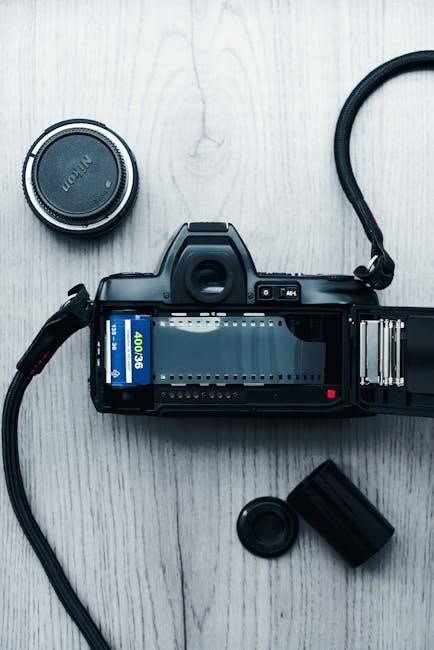
Lens Compatibility and Accessories
The Nikon D5000 is compatible with Nikon F-mount lenses, including the AF-S Nikkor 18-55mm VR kit lens. It also supports third-party lenses from brands like Tamron and Sigma. Additional accessories such as battery grips, external flashes, and remote controls enhance functionality and customization, ensuring versatility for various photography needs.
7.1 Compatible Lenses for Nikon D5000
The Nikon D5000 is compatible with a wide range of Nikon F-mount lenses, including DX-format and select FX-format lenses. The camera is often bundled with the AF-S Nikkor 18-55mm VR kit lens, which provides a versatile zoom range for everyday photography. Other compatible lenses include telephoto, wide-angle, and macro options, ensuring flexibility for various shooting scenarios. Third-party lenses from brands like Tamron and Sigma are also supported, offering additional choices for photographers. Using genuine Nikon lenses ensures optimal image quality and full compatibility with the camera’s features.
7.2 Using Nikon Accessories
The Nikon D5000 supports a variety of accessories to enhance your photography experience. The Nikon Manual Viewer 2 app allows you to download and view camera manuals on your smartphone or tablet. Approved memory cards, such as SanDisk and Lexar, ensure reliable storage for your images. Additional accessories like external flashes, remote controls, and battery grips can expand the camera’s functionality. Using genuine Nikon accessories guarantees compatibility and optimal performance, helping you make the most of your D5000’s capabilities.

Troubleshooting Common Issues
The Nikon D5000 manual provides solutions for common issues, such as error messages and camera malfunctions. Refer to the troubleshooting section for guidance on resolving problems and ensuring optimal performance.
8.1 Error Messages and Solutions
The Nikon D5000 manual addresses common error messages, such as “Error” when the mirror fails to lower, often resolved by checking the memory card or battery. Other errors like “For” or “Chk” may indicate lens or setting issues. The manual provides step-by-step solutions, including turning the camera off and on or resetting to default settings. It also advises checking lens compatibility and ensuring proper connections. By following these guidelines, users can quickly identify and resolve issues, ensuring uninterrupted photography sessions and optimal camera performance.
8.2 Common Problems and Fixes
The Nikon D5000 manual highlights common issues, such as the mirror not lowering after shutter release. Solutions include cleaning the mirror or sensor with a blower and avoiding liquid cleaners. Another issue is slow autofocus, which can be fixed by ensuring lens firmware is updated and using AF-S lenses. The manual also addresses LCD brightness problems, recommending adjustments in the camera menu. By following these troubleshooting steps, users can maintain their camera’s functionality and extend its lifespan, ensuring reliable performance for years to come.

Maintenance and Cleaning
Regularly clean the Nikon D5000 sensor and mirror with a bulb blower to prevent dust buildup. Avoid using liquid cleaners to ensure optimal performance and longevity of the camera.
9.1 Cleaning the Sensor and Mirror
Cleaning the sensor and mirror of your Nikon D5000 is essential for maintaining image quality. Use a bulb blower to gently remove dust from the mirror and sensor. Avoid touching the sensor or mirror with your fingers or cloths, as this can cause damage or leave residue. For more thorough cleaning, use a soft-bristle brush designed for camera sensors. Never use liquid cleaners, as they can harm the sensor’s coating. If dust persists, consider using a hand-pumped blower or consulting a professional. Regular cleaning ensures your camera captures sharp, dust-free images.
9.2 Maintaining the Camera Body
Regular maintenance of the Nikon D5000 camera body is crucial for ensuring longevity and optimal performance. Use a soft, dry cloth to wipe down the exterior, avoiding harsh chemicals or abrasive materials. Prevent dust from entering the camera by keeping the lens mount covered when not in use. Store the camera in a cool, dry place to avoid moisture damage. For more thorough cleaning, use a slightly damp cloth but avoid liquids near electronic components. Handle the camera with care to prevent scratches or dents. Regular maintenance ensures your D5000 remains in excellent condition for years of reliable use.
Downloading and Updating the Manual
The Nikon D5000 manual can be downloaded from Nikon’s official website in PDF format, ensuring access to the latest updates and detailed instructions. Use the Nikon Manual Viewer 2 app for mobile devices to conveniently access the guide anytime, anywhere.
10.1 Official Nikon Manual Download
The official Nikon D5000 manual is available for download from Nikon’s website in PDF format, providing detailed instructions for camera operation. Visit the Nikon support page, select your camera model, and download the manual free of charge. The guide includes comprehensive information on camera features, settings, and troubleshooting. Additionally, Nikon offers the Manual Viewer 2 app for smartphones and tablets, allowing you to access the manual on the go. Ensure you always use the official source to get the most accurate and up-to-date information for your camera. This resource is essential for maximizing your Nikon D5000 experience.
10.2 Updating Firmware and Software
Regularly updating the firmware and software for your Nikon D5000 ensures optimal performance and access to the latest features. Visit Nikon’s official website, navigate to the support section, and download the latest firmware updates. Connect your camera to your computer via USB and follow the on-screen instructions to complete the update. Additionally, Nikon provides software like ViewNX 2 and Manual Viewer 2 for enhanced image management and manual access. Always use a fully charged battery and avoid interruptions during updates to prevent issues. This ensures your camera operates at its best and supports the latest advancements in photography.
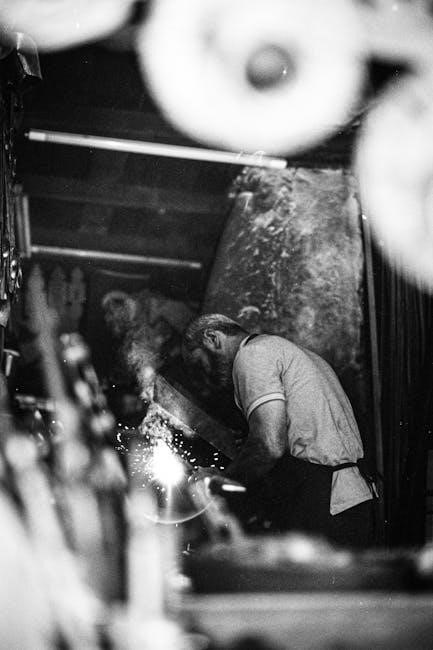
Registering Your Nikon D5000
Registering your Nikon D5000 provides access to exclusive updates, technical support, and warranty benefits. Visit Nikon’s official website, create an account, and follow the registration process to ensure your camera is protected and up-to-date.
11.1 Benefits of Registration
Registering your Nikon D5000 unlocks several advantages, including access to exclusive software updates, technical support, and warranty extensions. Registered users receive priority service, ensuring any issues are resolved promptly. Additionally, Nikon offers personalized tips, tutorials, and promotional offers tailored to your camera model. Registration also provides a record of ownership, which can be beneficial for insurance purposes or if the camera is lost or stolen. By registering, you stay informed about new features, firmware updates, and accessories, ensuring your camera remains optimized for peak performance. This simple process enhances your overall ownership experience and keeps you connected to Nikon’s ecosystem.
11.2 How to Register Your Camera
To register your Nikon D5000, visit Nikon’s official website and navigate to the product registration page. Create an account or log in if you already have one. Fill in the required personal details and enter your camera’s serial number, found on the camera body or in the battery compartment. Once submitted, you’ll receive a confirmation email. Registration ensures warranty validation, access to exclusive updates, and personalized support. Keep your registration details safe for future reference, as they may be required for service or repairs. This process is quick and enhances your ownership experience.
Mastering the Nikon D5000 requires practice and exploration of its features. Experiment with modes, customize settings, and maintain your camera for optimal performance. For further learning, explore Nikon’s official resources and community forums to refine your skills and stay updated on the latest techniques. Happy shooting!
12.1 Maximizing Camera Potential
To maximize the potential of your Nikon D5000, explore its advanced features such as manual modes, bracketing, and HD video recording. Regularly update firmware and use compatible lenses for optimal performance. Clean the sensor and maintain the camera body to ensure longevity. Experiment with different settings and techniques to enhance your photography skills. Refer to the manual for guidance on customizing preferences and troubleshooting common issues. By understanding and utilizing all the capabilities of the D5000, you can achieve professional-quality images and videos.
12.2 Additional Resources for Learning
Supplement your knowledge with resources like Nikon’s official website, which offers downloadable manuals and guides. The Nikon Manual Viewer 2 app provides easy access to instructions on your mobile device. Online forums, tutorials, and workshops can deepen your understanding of advanced techniques. Explore user communities for shared tips and experiences. Additionally, Nikon’s customer support and educational content, such as video tutorials, can help you refine your skills. These resources ensure you stay updated and make the most of your Nikon D5000 experience.
